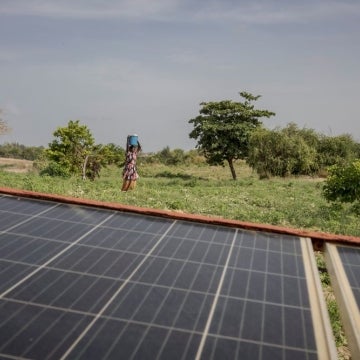In the first blog of our series on the World Bank’s latest Global Findex 2025, we highlighted that while notable progress has been made in financial inclusion since the Findex launched in 2011, there is much more still to be done.
To close the last-mile gaps and improve livelihoods by broadening the range of suitable financial services that are available, we need to develop and scale new solutions.
CGAP and Accion’s work suggests that there are six clear opportunities that need to be prioritized:
1. Smart use of next-generation technology
New technologies like artificial intelligence present fresh opportunities for expanding access and usage for communities that have historically proved harder to reach.
One of the most promising applications is for alternative credit scoring. Traditionally, lending has relied heavily on physical collateral; however, this model has excluded many potential borrowers. The ability to make sense of thousands of unstructured data points, such as the daily sale transactions of a microentrepreneur, and turn them into useful, predictive analysis to assess creditworthiness, brings huge opportunity to improve credit scoring models even for customers without credit history or collateral.
CGAP’s work also points to the use of data and AI for product innovation and increasing consumer choice. Supporting the expansion of inclusive insurance is one example, where data can be used for better understanding customer behavior, designing and pricing more responsive products, providing a smoother customer acquisition and onboarding, and building efficiency in claims management and fraud detection.
While GenAI must be used with some caution and we must remain acutely aware of potential bias in algorithms, it presents a huge, largely untapped opportunity as 900 million of the world’s 1.3 billion unbanked adults now own a cellphone and generate data trails.
2. Strategic investment in DPI and Open Finance
To unlock these notable benefits in data and GenAI, governments need to invest adequately in inclusive Digital Public Infrastructure (DPI) and Open Finance.
DPI – which encompasses digital identity systems; connectivity; and secure, interoperable payment systems – ensures that people are digitally connected and generate invaluable data trails.
Open Finance is the last element of DPI and is a policy framework that enables customers and businesses to securely transfer their financial and other data to other financial institutions and third-party providers such as fintechs, which in turn creates competition in financial markets and provides the basis for data-driven product innovations to better serve customers.
Just like roads connecting people and businesses, DPI and Open Finance create a network for delivering digital services. Financial service providers can build on this foundation to provide people with responsible credit, savings, insurance, and other financial tools to improve their economic wellbeing.
Amid a surge of implementations worldwide, India and Brazil are pioneering DPI and Open Finance in developing economies, witnessing significant impact in just over two years. In India, as of March 2024, about 64 million accounts have been linked through the Account Aggregator (AA) ecosystem – India’s version of open finance – and in Brazil, over 43 million accounts have been linked through open finance. Key factors like interoperable fast payment systems (UPI in India and Pix in Brazil), and a flourishing fintech market have fueled this growth. According to the Global Findex 2025, in India 89% of adults now have a financial account and in Brazil it is 83.6%.
DPI and Open Finance require significant public investment and since we believe they will be the foundation of future progress for financial inclusion, they need to be conceived with inclusion in mind. For example, a core priority must be closing digital connectivity gaps, which are more prevalent amongst financially excluded communities. The Global Findex 2025 finds indeed that 31% of adults without a financial account also do not own any type of mobile phone. In building DPI and Open Finance systems, countries must also avoid shifting the cost burden onto consumers as this would make basic digital and financial services inaccessible to low-income communities. Protecting privacy will also be important, and robust safeguards are needed to avoid data misuse.
3. Deploying new tools to crowd in private sector capital and expertise
While new innovations, such as those based on data and open finance, have the potential to make a huge difference to increasing the breadth and depth of financial inclusion, most still fail to scale because of a lack of finance.
CGAP’s research has found that inclusive credit fintechs for example face considerable funding challenges; 54% of inclusive credit fintechs do not make it past the first round of funding and only 15% will complete three or more funding rounds (Kruijff and Sotiriou 2025).
Sometimes this is a result of a poor product-market fit, or because of an inadequate funding runway for inclusive credit fintechs. Regardless of the cause, it means there has never been a greater need for private sector capital and expertise. Blended finance will be an important part of the solution. According to the latest CGAP Funder Survey, in 2022 public funders and charitable foundations allocated US $2.4 billion to the equity piece of investment funds dedicated to expanding financial inclusion, and US $2 billion was allocated to guarantees incentivizing and supporting Inclusive Financial Institutions (IFIs) in expanding their lending to underserved populations.
Such investments have catalyzed private investments towards deeper and more efficient financial inclusion but there is an urgent need to scale this further to materially bridge the “last-mile” and expand the suite of financial products available – especially in relation to gender, climate resilience and SME financing gaps where risks are large for private investors.
Accion’s investment model also helps to address these challenges. Accion uses its balance sheet to first test new financial sector innovations and learn, before leveraging the capital markets to take innovations to scale.
One underlying challenge is the difficulty in aligning the incentives of donors, Development Finance Institutions (DFIs), and fund managers, which can result in some concessional resources being absorbed without effectively crowding in private capital, or achieving development outcomes, or driving standardization and replicability. CGAP has launched an effort to help develop solutions to these key challenges, working with its members and partners.
4. An unwavering focus on outcomes
A focus on outcomes is essential to drive action where it can be most impactful, course correct, and make sure we reach our end goals. But to focus on outcomes, we need first to understand what works and then measure it and define indicators that can serve as our compass.
Despite a growing body of evidence, significant gaps remain in understanding why financial services drive positive change in some scenarios but not others. For this reason, CGAP launched the Financial Inclusion 2.0 initiative to catalyze the sector to focus more on outcomes.
Financial Inclusion 2.0 aims to curate existing evidence and generate new methods and insights in order to empower stakeholders to better understand when and how financial services contribute to meaningful development outcomes.
This work includes the Impact Pathfinder, a new tool that leverages existing research to outline pathways for how financial services and products can contribute to key development outcomes, such as building resilience, promoting women’s economic empowerment, creating job opportunities, and improving access to education and healthcare. Going forward, it will be important for donors, investors, policymakers, and financial service providers to use these insights when designing interventions to ensure they maximize benefits for underserved populations.
5. Provision of complementary services
To expand access to the most excluded populations and create long-term impact, digital innovations must be bundled with complementary financial and non-financial services, tools, and business support that strengthens financial literacy, business skills, and market access.
Financial literacy programs can improve underserved communities’ ability to use digital tools effectively. Embedding training into digital platforms at a “teachable moment”, such as during product onboarding, can help users develop investment strategies and manage growth sustainably.
CGAP’s work shows that policies and initiatives that are developed with particular groups in mind are particularly important. For example, for women, there are a number of financial and non-financial ways to boost autonomy such as granting women the legal right to own assets and sign contracts independently, providing targeted subsidies, and streamlining business registration as these can empower women entrepreneurs to participate fully in formal financial and business sectors.
6. Underpinning everything with robust consumer protection that builds and maintains trust
Greater consumer trust among vulnerable communities will be paramount in making the much-needed last-mile gains in both access and usage – after all, expanding the availability and suitability of products is irrelevant if end-users don’t fully understand them or their benefits.
Increasing financial inclusion will also mean reaching populations that are first-time users of financial services, who are likely to be much less financially literate, and in some cases less digitally literate too. This can result in a higher level of mistrust and more vulnerability to fraud and mistakes, all of which can contribute to lower use.
Indeed, a recent survey by the Center for Financial Inclusion at Accion of 20,000 micro and small businesses found that those that adopted digital tools saw an increase in productivity of up to 10% for each new tool they adopted, yet in many countries usage of these tools remains stubbornly low, largely due to infrastructure issues, but also increasingly due to a lack of trust.
Beyond direct experience, the research found that the fear of falling victim to fraud, scams, or mistreatment also weighs heavily on small business owners. During focus group discussions across five cities (Addis Ababa, Jakarta, Lagos, New Delhi, and Sāo Paulo), entrepreneurs consistently described knowing peers who had lost money through mobile payments, loan apps, or digital wallets. This sense of risk, often amplified by word-of-mouth, creates a climate of caution that deters many from adopting digital tools or formal financial services.
With more and more consumers using digital financial services, the scope and impact of risks are expanding rapidly. As CGAP set out in its Responsible Digital Finance Ecosystem (RDFE) conceptual framework, mitigating these risks will require individual and collective action from a wide range of financial and non-financial sector authorities such as data protection, competition, or telecom regulators, along with a broad range of digital finance providers, consumer advocates, and market facilitators. Working together, these stakeholders will need to build on and strengthen— not replace — countries’ current digital financial services frameworks, including their regulation and supervision.
Clearly, there is still much to do to realize the full promise of financial inclusion. As we celebrate the progress made, we can move forward with renewed confidence and optimism. We have the tools needed to close the gaps and increase impact. We also have a golden opportunity to leverage data and digital innovations. But success will require intentionality, investment, collaboration, and an unwavering focus on results. The time to act is now.



